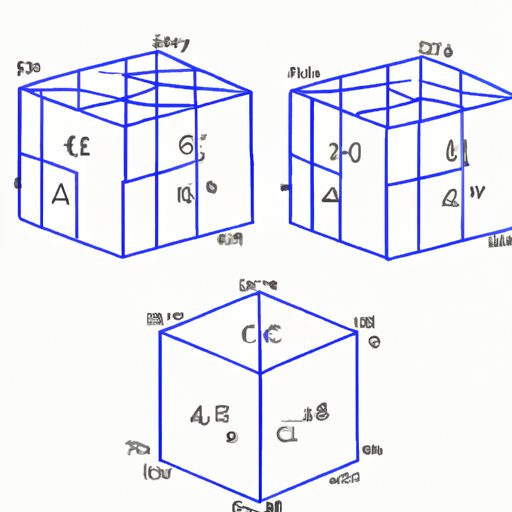
I. Introduction
Are you struggling to find the surface area of a cube? It may seem like a daunting task, but with the right guidance, even beginners can solve this geometry puzzle with ease. In this article, we will guide you step-by-step on how to find the surface area of a cube. We will explore the definition of a cube, its importance, and how to use its formula. By the end, you’ll have a deeper understanding of cube geometry and its applications in real-life problems.
II. Beginner’s Guide: How to Find Surface Area of a Cube
A cube is a three-dimensional figure with six square faces of equal size. The surface area of a cube is the total area of all its faces added together. It is important to know how to find surface area as it is used in many fields like architecture, engineering, and design.
Let us begin with a simple diagram to give you a better visual understanding:

III. The Simple Math: Steps to Find the Surface Area of a Cube
The formula for finding the surface area of a cube is A = 6s², where A represents the surface area and s is the length of one side of the cube.
To help understand the formula, let us break it down:
- The cube has six faces, so you need to multiply the area of one face by six to find the total surface area.
- The area of one face is simply the length of one side squared (s²).
- So, to find the total surface area, you multiply s² by 6.
Here is a step-by-step guide to finding the surface area of a cube using the formula:
- Measure the length of one side of the cube (s).
- Square the length of one side (s²).
- Multiply s² by six (6s²).
IV. Solving the Puzzle: Quick Tips for Calculating Cube Surface Area
When finding the surface area of a cube, there are a few common mistakes to avoid:
- Remember to square the length of one side, not multiply by two.
- Make sure you are measuring the length of one side, not the diagonal or circumference.
- Double check your calculations to avoid errors.
Here are some tips to simplify the calculation:
- You can calculate the surface area of a cube quicker if you already know the length of one diagonal, d, along a face, then surface area, A, of the cube is A = 3d².
- If the cube has been cut into smaller cubes, find the surface area of each cube and add them together to find the total surface area of the larger cube.
- Practice with example problems to improve your skills and speed.
Try this example problem:
A cube has a side length of 5 cm. Find the surface area of the cube.
- s = 5 cm
- s² = 25 cm²
- 6s² = 150 cm²
Therefore, the surface area of the cube is 150 cm².
V. Visualizing a Cube: Understanding the Formula to Find Surface Area
Visual aids can help you understand the structure of a cube better and how the formula is derived from it. There are interactive tools available online to help you practice with cubes and analyze the impact of side length s on surface area A.
The formula is derived from the notion that a cube has six equal faces, so by multiplying the area of one face by six, you get the total surface area of the cube. This total area can also be thought of as the sum of each face’s area.
VI. Practice Makes Perfect: Applying the Surface Area of Cube to Real Life Examples
Understanding the surface area of a cube can be useful in solving real-life problems. For example, if the surface area of a container is known, one can determine the container’s volume. Architects and engineers use the surface area of a building to determine the amount of materials needed for construction.
Take another example problem:
A cube-shaped box has a surface area of 150 cm². What is the volume of the box?
To find the volume of the box, you first need to determine the length of one side of the cube:
- 150 cm² = 6s²
- divide both sides by 6: 25 = s²
- s = 5 cm (one side length)
Now that you know the side length, you can find the volume:
- s³ = 125 cm³ (volume of one cube)
Therefore, the volume of the box is 125 cm³.
VII. Conclusion
Knowing how to find the surface area of a cube is an essential skill in many fields. We’ve shown you that it is easy to understand and calculate with the right guidance. We’ve covered the definition of a cube, its importance, the formula for finding surface area, common mistakes, and tips and shortcuts to simplify the process. Visualization can help you understand the concept of a cube better, and real-life applications demonstrate its significance in practical problem-solving. We encourage you to keep practicing the concept and apply it to real-world situations.




